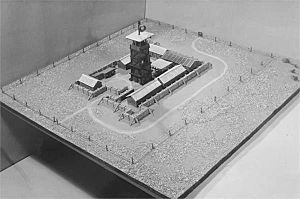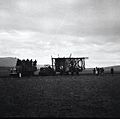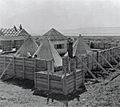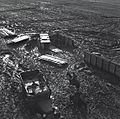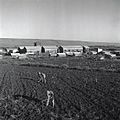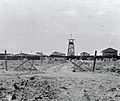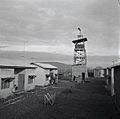Tower and Stockade facts for kids
Tower and Stockade (called Ḥoma u'migdal in Hebrew, meaning 'wall and tower') was a special way of building new communities used by Zionist settlers in Mandatory Palestine (which is now Israel) during a time of trouble called the Arab Revolt (1936-1939).
At that time, the British authorities, who governed the area, had rules about building new Jewish settlements. However, they often quietly allowed these "Tower and Stockade" projects because it helped them deal with the Arab Revolt. During this period, about 57 Jewish settlements were built this way. Most of them were kibbutzim (community farms) and some were moshavim (cooperative farms).
The reason these buildings were allowed was because of an old Turkish Ottoman law. This law said that if a building's roof was finished, it couldn't be torn down, even if it was built without official permission. This rule helped the settlers quickly establish their new homes.
Contents
Why Were These Settlements Built?
During the Arab Revolt, these new settlements were very important. They acted as safe places on land that had been bought by the Jewish National Fund (JNF). They protected Jewish people, especially in faraway areas. These settlements also helped create "facts on the ground," meaning they showed that Jewish people were living and working in these areas.
Over time, these settlements became strong farming communities. They were used for security, helping to defend against attacks. They also created areas where many Jewish people lived close together. This later helped decide the borders of the Jewish state proposed by the United Nations.
Who Organized the Tower and Stockade?
The whole operation was run by the Haganah, which was a Jewish defense organization. It was led by Moshe Sharett, who later became a leader in Israel.
Many different settlement groups, mostly kibbutzim and moshavim, took part. The idea was to quickly build a guard tower and put a fence around it. Even though many of these settlements weren't officially approved by the British, they weren't torn down because of that old Turkish law.
How Were They Built So Fast?
Because there was a risk of immediate attack, the settlements had to be built very quickly, usually in just one day! People often think they were built at night to hide from the British, but actually, they were always built during the day. The British authorities were not very strict about stopping these Jewish activities because they were more focused on dealing with the Arab Revolt.
The idea for the "Tower and Stockade" system came from Shlomo Gur, one of the founders of Kibbutz Tel Amal (now Nir David). It was further developed by an architect named Yohanan Ratner.
The system used wooden frames that were made beforehand. These frames would be filled with gravel and surrounded by barbed wire fences. On average, the fenced area was about 35 by 35 meters (about the size of a small football field). Inside this protected area, the pre-made wooden observation tower and four small sheds for the first 40 settlers were put up. These new communities were built close enough to other settlements so they could see each other and be reached by vehicles.
Between late 1936 and October 1939, 57 such settlements were built. The buildings were made by Solel Boneh, a construction company that belonged to the Jewish trade union, Histadrut.
A model of a Tower and Stockade settlement was even shown at the 1937 World Exposition in Paris!
Later Settlements: The Ussishkin Fortresses
In 1940, two more outposts were built in the northern Hula valley: She'ar Yashuv and Beit Hillel. These, along with nearby Dafna and Dan, were known as the "Ussishkin Fortresses." They were named after Menachem Ussishkin, who was the president of the Jewish National Fund. The original plan was to build one "fortress" for each of the six main settlement groups at the time.
Tower and Stockade Settlements List
Here are some of the Tower and Stockade settlements, listed by when they were built:
- Kfar Hittim, December 7, 1936
- Tel Amal (now Nir David), December 10, 1936
- Sde Nahum, January 5, 1937
- Sha'ar HaGolan, January 31, 1937
- Masada, January 31, 1937
- Ginosar, February 25, 1937
- Beit Yosef, April 9, 1937
- Mishmar HaShlosha, April 13, 1937
- Tirat Tzvi, June 30, 1937
- Moledet, July 4, 1937
- Ein HaShofet, July 5, 1937
- Ein Gev, July 6, 1937
- Maoz Haim, July 6, 1937
- Kfar Menachem, July 27, 1937
- Sha'ar HaNegev (later Kfar Szold), August 15, 1937
- Tzur Moshe, September 13, 1937
- Usha, November 7, 1937
- Hanita, March 21, 1938
- Shavei Tzion, April 13, 1938
- Sde Warburg, May 17, 1938
- Ramat Hadar, May 26, 1938
- Alonim, June 26, 1938
- Ma'ale HaHamisha, July 17, 1938
- Tel Yitzhak, July 25, 1938
- Beit Yehoshua, August 17, 1938
- Ein HaMifratz, August 25, 1938
- Ma'ayan Tzvi, August 30, 1938
- Sharona, November 16, 1938
- Geulim, November 17, 1938
- Eilon, November 24, 1938
- Neve Eitan, November 25, 1938
- Kfar Ruppin, November 25, 1938
- Kfar Masaryk, November 29, 1938
- Mesilot, December 22, 1938
- Ayalon, January 1, 1939
- Dalia, May 2, 1939
- Dafna, May 3, 1939 (Ussishkin Fortress 1)
- Dan, May 4, 1939 (Ussishkin Fortress 2)
- Sde Eliyahu, May 8, 1939
- Mahanayim, May 23, 1939
- Shadmot Dvora, May 23, 1939
- Shorashim, May 23, 1939
- Hazore'im, May 23, 1939
- Tel Tzur, May 23, 1939
- Kfar Glikson, May 23, 1939
- Ma'apilim, May 23, 1939
- Mishmar HaYam (now Afek), May 28, 1939
- Hamadiyah, June 23, 1939
- Kfar Netter, June 26, 1939
- Negba, July 12, 1939
- Gesher, August 13, 1939
- Beit Oren, October 1, 1939
- Amir, October 29, 1939
- Beit Hillel, January 3, 1940
- She'ar Yashuv, February 1940 (Ussishkin Fortress 3)
Images for kids
-
Amir 1940
See also
- Three lookouts (in the Negev), 1943 settlements, created as advanced positions in southern Palestine/northern Negev
- 11 points in the Negev, 1946 settlements created prior to the partition of Palestine
- Tegart fort, British police and border forts built during the 1930s Arab revolt


